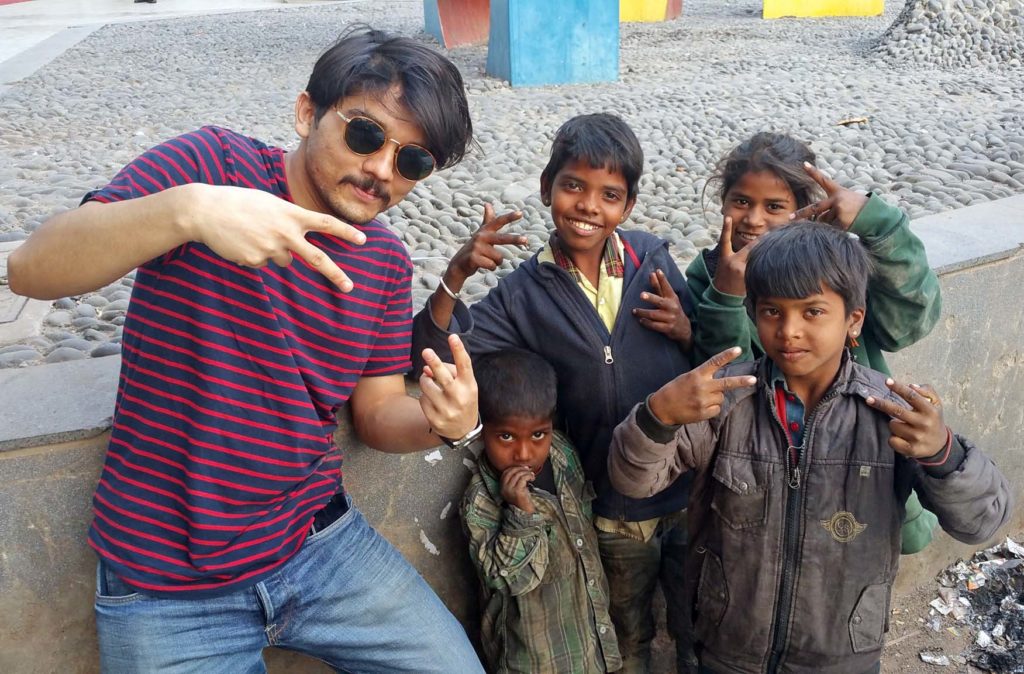
New School Students Tackle ‘Wicked’ Urban Issues in India as Part of Design for a Billion Project
Arriving in Gandhinagar, India, in January 2018, students from across The New School encountered a very different environment from the New York City campus they’re used to.
While they may have been on unfamiliar terrain, their design expertise came in handy in tackling a number of major issues impacting Indian society: transportation, hygiene, education, waste management, and water purification and recycling.
The students were there as part of Design for a Billion, a two-week collaboration studio created by The India Institute of Technology, Gandhinagar (IITGN) and Parsons School of Design’s Design and Technology programs. Led by Sven Travis and Anezka Sebek, associate professors from Parsons’ School of Art, Media, and Technology, students did onsite design research at the new IITGN campus, a short driving distance from the major city of Ahmedabad (located on the west coast of India between New Delhi and Mumbai, it was the home base of Mohandas K Gandhi).
“IITGN, with its focus on engineering, and Parsons, with its focus on design, wanted to see what a diverse group of students from all over the world would do with the deep-seated and wicked problems affecting India,” Sebek says. “The idea was to use Ahmedabad as a large city and Palaj as a small village outside of the gates of IITGN as case studies to create possible, albeit quick prototypical solutions that could scale to all of India.”

“There was also great interest in comparing approaches to design process — often very different between designers and engineers,” Travis adds.
Students used the iterative design process to explore India’s infrastructure problems, which are linked to socio-cultural, environmental, and economic issues. To contextualize their work and to frame their research, students attended a series of lectures by IITGN faculty about Indian politics and culture, as well as engineering-specific topics such as manufacturing, material science, and mechatronics. Students were then divided into five collaborative groups that designed, tested ideas, and created prototypes in communities in and around the IITGN and Ahmedabad.
For the Ahmedabad’s Bus Rapid Transit System, students proposed redesigns for the interior layout of public buses and researched alternative digital ticketing for the transport system. Regarding hygiene, they worked on ways to raise awareness on menstruation hygienic practices, a topic considered taboo in many Indian villages. With an eye toward improving the education system, they created a way for the Palaj Village Elementary School students to contribute playfully and to create consciousness about the problems of trash and pollution. To address the mounds of trash from packaging of single-serve products, the students created a system map that showed the contributing factors that lead to the persistence of the problem. Another group of collaborators created a working prototype of a hand-cranked, low-water consumption, ceramic bead washing machine to replace the high consumption of soap and water of hand-washing.

While students may have been at first overwhelmed by the enormity of the task in front of them, they rose to the occasion, using their “tremendous creativity, and design training to confront some of the biggest issues facing one of the world’s biggest countries,” Sebek says.
Beyond the classroom, New School students were exposed to a vibrant and distinct culture. They visited the Gandhi Ashram in Ahmedabad, participated in the local kite festival, and visited National Institute of Design, India’s preeminent design school, in Ahmedabad. They benefited from the guidance of Kuldeep Gohel, MFA D+T ‘18, a teaching assistant and native of Ahmedabad.
“It is impossible to overestimate the value of Kuldeep on this trip,” Travis says. “He is a true ‘native,’ and he was able to expose the group to aspects of the local community and culture we wouldn’t have seen otherwise.”
Sebek and Travis expressed gratitude to IITGN faculty and teaching assistants “for the tremendous work done in support of the project.”
“This would have been impossible without real hard work on IITGN’s part,” Travis says. “There was real dedication to establishing an ongoing engagement with The New School, and the result is that we’ve started what we believe can be a sustainable relationship.”
